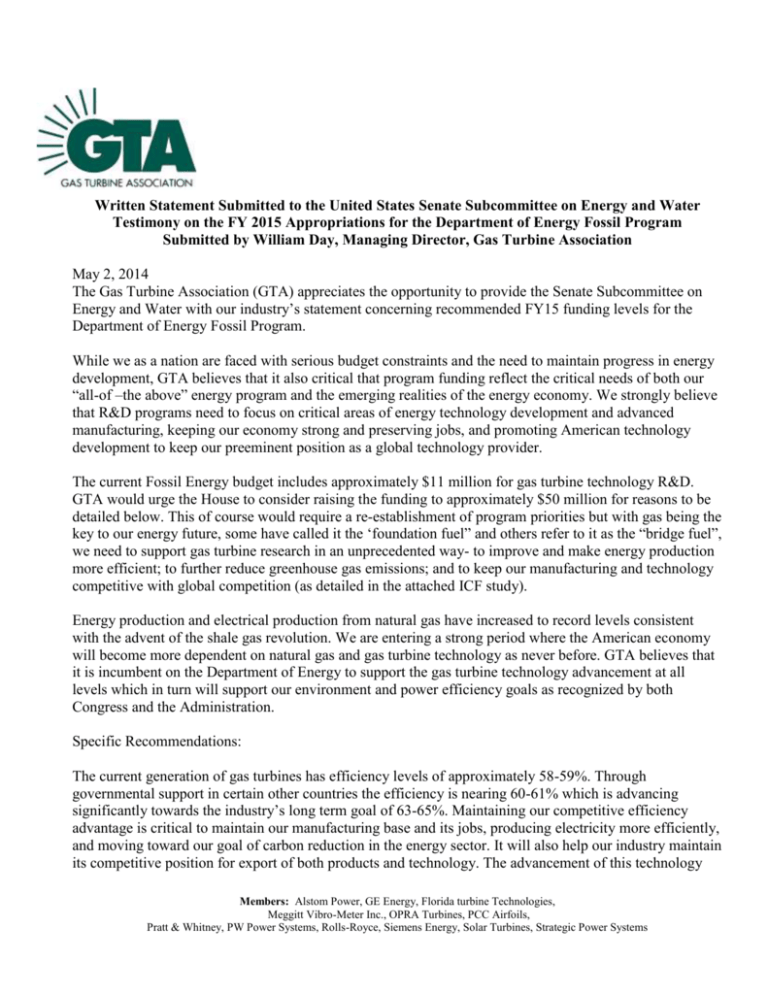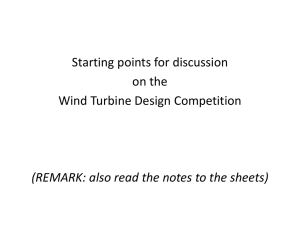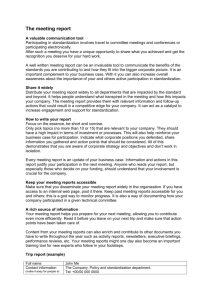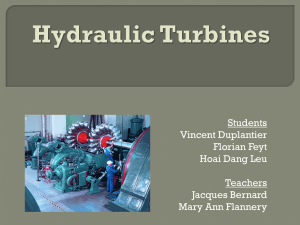Testimony to the Senate on the FY 2015 Fossil Energy Budget
advertisement

Written Statement Submitted to the United States Senate Subcommittee on Energy and Water Testimony on the FY 2015 Appropriations for the Department of Energy Fossil Program Submitted by William Day, Managing Director, Gas Turbine Association May 2, 2014 The Gas Turbine Association (GTA) appreciates the opportunity to provide the Senate Subcommittee on Energy and Water with our industry’s statement concerning recommended FY15 funding levels for the Department of Energy Fossil Program. While we as a nation are faced with serious budget constraints and the need to maintain progress in energy development, GTA believes that it also critical that program funding reflect the critical needs of both our “all-of –the above” energy program and the emerging realities of the energy economy. We strongly believe that R&D programs need to focus on critical areas of energy technology development and advanced manufacturing, keeping our economy strong and preserving jobs, and promoting American technology development to keep our preeminent position as a global technology provider. The current Fossil Energy budget includes approximately $11 million for gas turbine technology R&D. GTA would urge the House to consider raising the funding to approximately $50 million for reasons to be detailed below. This of course would require a re-establishment of program priorities but with gas being the key to our energy future, some have called it the ‘foundation fuel” and others refer to it as the “bridge fuel”, we need to support gas turbine research in an unprecedented way- to improve and make energy production more efficient; to further reduce greenhouse gas emissions; and to keep our manufacturing and technology competitive with global competition (as detailed in the attached ICF study). Energy production and electrical production from natural gas have increased to record levels consistent with the advent of the shale gas revolution. We are entering a strong period where the American economy will become more dependent on natural gas and gas turbine technology as never before. GTA believes that it is incumbent on the Department of Energy to support the gas turbine technology advancement at all levels which in turn will support our environment and power efficiency goals as recognized by both Congress and the Administration. Specific Recommendations: The current generation of gas turbines has efficiency levels of approximately 58-59%. Through governmental support in certain other countries the efficiency is nearing 60-61% which is advancing significantly towards the industry’s long term goal of 63-65%. Maintaining our competitive efficiency advantage is critical to maintain our manufacturing base and its jobs, producing electricity more efficiently, and moving toward our goal of carbon reduction in the energy sector. It will also help our industry maintain its competitive position for export of both products and technology. The advancement of this technology Members: Alstom Power, GE Energy, Florida turbine Technologies, Meggitt Vibro-Meter Inc., OPRA Turbines, PCC Airfoils, Pratt & Whitney, PW Power Systems, Rolls-Royce, Siemens Energy, Solar Turbines, Strategic Power Systems must be done with the Department of Energy leading a combined private/public strategic partnership to insure success and rapid market deployment. We need to accelerate and increase funding of certain programs at a significantly higher level in order to promote the development of more efficient large turbines for the electricity generation and small turbines to meet growing demand for industry and distributed generation. A goal that the current program had but did not meet was developing the fundamental technologies needed for advanced hydrogen turbines and to integrate this technology with CO2 separation, capture, and storage into a near-zero emission configuration that can provide electricity with less than a 10 percent increase in cost over conventional plants. This program needs significantly more funding to meet that goal. We also need to develop oxygen-fired (oxy-fuel) turbines and combustors that will achieve even higher efficiencies, with near-100 percent CO2 capture and near-zero NOx emissions. Additional needs are the development and integrated testing of new combustors, turbine components, advanced cooling technology, and materials required for oxy-fuel combustors and turbines needed to make these systems commercially viable. The knowledge and confidence that generating equipment will operate reliably and efficiently on different fuels is essential for the deployment of new technology. Years of continued under-funding of the Advanced Turbines program has already significantly delayed the completion dates for turbine R&D necessary for advanced IGCC as a case in point. Among other programs that should be led by the Department of energy are: increased fuel flexibility for higher Hydrogen fuels and alternate fuels; lower emission for NOx and CO on natural gas and alternate fuels; advancement in manufacturing of ceramic and composite materials; additive manufacturing; hot gas path cooling and materials. These are a few examples that will not only advance the industry but will make the US more competitive globally. Gas Turbines are a key to the future of our energy economy. Gas turbines produce less than half the CO2 per megawatt hour than other fossil fuels Gas turbines are key to stabilizing the electrical grid. Gas turbines are essential to backing up renewable energy sources with a rapid response capability. Gas turbines are a vital part of the growing distributive generation infrastructure. It is imperative that we recognize the value of gas turbine technology and support the development of this technology through the Department of Energy relying on its expertise in public/private partnerships to maximize the potential of every R&D dollar. The GTA respectfully requests $50 million in FY15 appropriations for the Fossil Energy Turbine Program to meet critical national goals including grid stability and reliability, fuel conservation, fuel flexibility, greenhouse gas reduction, and criteria pollutant reduction, as well as to insure the US maintains its dominate position in the global market. Gas Turbine Association, William H. Day, 510-705-1885 Email billday3@comcast.net Members: Alstom Power, GE Energy, Florida turbine Technologies, Meggitt Vibro-Meter Inc., OPRA Turbines, PCC Airfoils, Pratt & Whitney, PW Power Systems, Rolls-Royce, Siemens Energy, Solar Turbines, Strategic Power Systems








